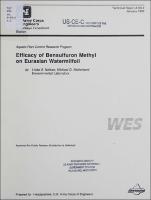Please use this identifier to cite or link to this item:
https://hdl.handle.net/11681/6374Full metadata record
| DC Field | Value | Language |
|---|---|---|
| dc.contributor.author | Nelson, Linda S. | en_US |
| dc.contributor.author | Netherland, Michael D. | en_US |
| dc.creator | Aquatic Plant Control Research Program (U.S.) | en_US |
| dc.creator | Environmental Laboratory (U.S.) | en_US |
| dc.date.accessioned | 2016-03-23T19:55:07Z | en_US |
| dc.date.available | 2016-03-23T19:55:07Z | en_US |
| dc.date.issued | 1993-01 | en_US |
| dc.identifier.govdoc | Technical Report A-93-2 | en_US |
| dc.identifier.uri | http://hdl.handle.net/11681/6374 | en_US |
| dc.description | Technical Report | en_US |
| dc.description.abstract | Studies to evaluate the efficacy of bensulfuron methyl on Eurasian watermilfoil (Myriophyllum spicatum L.) were conducted in a 55-l aquaria system under controlled-environment conditions. Forty-two bensulfuron methyl concentration and exposure time combinations were tested: concentrations ranged from 0 to 4,600 μg/l; exposure times ranged from 7 to 49 days . Chemical effectiveness was based on shoot and root biomass harvested at the conclusion of each experiment. Visual injury ratings were recorded weekly to characterize chemical activity. Herbicide injury was evident 1 week after application on all treatments and included one or more of the following symptoms: leaf chlorosis, deformed leaves on shoot tips, downward bending of leaves at upper nodes, stem necrosis, and formation of axillary buds. Following a 7-, 14-, 21-, 28-, 35-, 42-, and 49-day exposure period at concentrations ranging from 10 to 4,600 μg/l, plant biomass was reduced 10 to 90 percent compared with untreated plants. Increasing exposure time was more efficacious than increasing bensulfuron methyl concentration. Younger milfoil plants (7 days old) were also susceptible to bensulfuron methyl application than plants that were allowed a 3-week pretreatment growth period. Bensulfuron methyl concentrations <10 μg/l did not significantly reduce milfoil growth. Effects on roots were variable depending on concentration and plant age. Only treatments of 230 μg/l and higher inhibited root growth on plants grown for 3 weeks prior to treatment, whereas 50 μg/l was sufficient to reduce root growth of younger plants. Regrowth was observed on all treatments, indicating the potential for plant recovery. Regrowth emerged from rootcrowns, axillary buds, and injured shoot apices and was evident 1 to 2 weeks following completion of the exposure period and removal of the bensulfuron-methyl-treated water. Complete plant control (plant death) was not achieved at the concentrations and exposure times tested in these studies. | en_US |
| dc.description.sponsorship | Aquatic Plant Control Research Program (U.S.) | en_US |
| dc.description.sponsorship | United States. Army. Corps of Engineers | en_US |
| dc.description.tableofcontents | Preface..................................1 Introduction..................................3 Materials and Methods..................................6 Studies 1 and 2..................................7 Study 3..................................9 Study 4..................................9 Results and Discussion..................................10 Study 1..................................10 Study 2..................................13 Study 3..................................16 Study 4..................................18 Conclusions..................................20 Recommendations..................................21 References..................................22 | en_US |
| dc.format.extent | 28 pages/5.88 MB | en_US |
| dc.format.medium | en_US | |
| dc.language.iso | en_US | en_US |
| dc.publisher | U.S. Army Engineer Waterways Experiment Station | en_US |
| dc.relation | http://acwc.sdp.sirsi.net/client/en_US/search/asset/1043532 | en_US |
| dc.relation.ispartofseries | Technical Report (Aquatic Plant Control Research Program (U.S.)) ; no.Technical Report A-93-2 | en_US |
| dc.rights | Approved for public release; distribution is unlimited | en_US |
| dc.source | This Digital Resource was created from scans of the Print Resource | en_US |
| dc.subject | Bensulfuron methyl | en_US |
| dc.subject | Biomass | en_US |
| dc.subject | Eurasian watermilfoil | en_US |
| dc.subject | Aquatic plants | en_US |
| dc.subject | Aquatic vegetation | en_US |
| dc.subject | Aquatic plant control | en_US |
| dc.subject | Exposure time | en_US |
| dc.subject | Herbicide | en_US |
| dc.subject | Evaluation | en_US |
| dc.subject | Sulfonylurea | en_US |
| dc.subject | Aquatic Plant Control Research Program (U.S.) | en_US |
| dc.title | Efficacy of bensulfuron methyl on eurasian watermilfoil | en_US |
| dc.type | Report | en_US |
| Appears in Collections: | Technical Report | |
Files in This Item:
| File | Description | Size | Format | |
|---|---|---|---|---|
| TR-A-93-2.pdf | Technical Report A-93-2 | 5.88 MB | Adobe PDF |  View/Open |